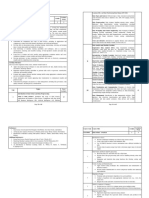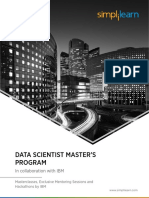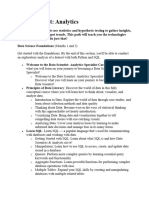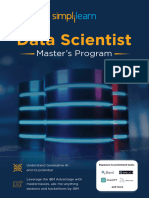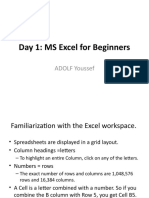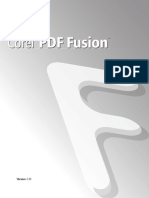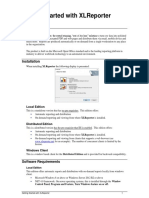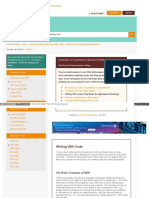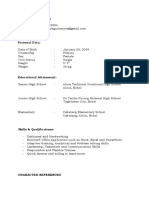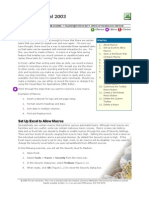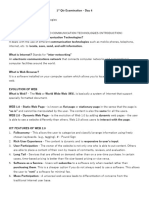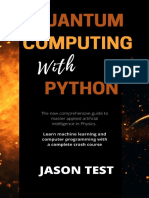SMEC
Detailed Syllabus
Course Name : Master in Data Analytics
Key Features:
Experiential Learning
Offline/Online Classes
20+ practices sessions on all modules
Case studies and assignments
Hands on Projects
Mentoring Sessions
Job Assistance
Learning Pathway:
• Learn python program from scratch.
• Statistical and mathematical essential for Data Science
• Data Science with python
• Data Science with R
• Data visualization with Tableau and Power BI
Program Outcomes:
Deep understanding of data structure and data manipulation.
Gain expertise in mathematical computing using the NumPy.
Gain expertise in Exploratory data analysis using pandas, matplotlib and seaborn.
Gain expertise in time series modeling.
1. Learn Python Program from Scratch
Programming is an increasingly important skill; this program will establish your proficiency in handling basic
programming concepts. By the end of this program, you will understand object-oriented programming; basic
programming concepts such as data types, variables, strings, loops, and functions; and software engineering using
Python.
1.1 Objectives:
Gain fundamental knowledge of programming basics.
Achieve an understanding of object-oriented programming principles including data types,variables,
strings, loops, strings, lists, functions, and classes etc.
Comprehend software engineering concepts, using Python.
Page 1
www.smeclabs.com
� SMEC
1.2 Program Curriculum:
• Course Introduction
• Programming
2. Statistical and Mathematical Essential for Data Science
Statistics is the science of assigning a probability through the collection, classification, and
analysis of data. A foundational part of Data Science, this session will enable you to define statistics
and essential terms related to it, explain measures of central tendency and dispersion, and comprehend
skewness, correlation, regression, distribution. Understanding the data is the key to perform
Exploratory Data analysis and justify your conclusion to the business or scientific problem.
2.1 Objectives:
Understand the fundamentals of statistics
Work with different types of data
How to plot different types of data
Calculate the measures of central tendency, asymmetry, and variability
Calculate correlation and covariance
Distinguish and work with different types of distribution
Estimate confidence intervals
Perform hypothesis testing
Make data-driven decisions
Understand the mechanics of regression analysis
Carry out regression analysis
Use and understand dummy variables
Understand the concepts needed for Data Science even with Python
2.2 Program Curriculum:
1. Introduction
2. Sample or Population Data?
3. The Fundamentals of Descriptive Statistics
4. Measures of Central Tendency, Asymmetry, and Variability
5. Practical Example: Descriptive Statistics
6. Distributions
7. Estimators and Estimates
8. Confidence Intervals Lesson
9. Practical Example: Inferential Statistics
Page 2
www.smeclabs.com
� SMEC
10. Hypothesis Testing: Introduction
11. Practical Example: Hypothesis Testing
12. The Fundamentals of Regression Analysis
13. Assumptions for Linear Regression Analysis
14. Dealing with Categorical Data
15. Practical Example: Regression Analysis
3. Data Science with Python:
Perform fundamental hands-on data analysis using the Jupyter Notebook and PyCharm based
lab environment and create your own Data Science projects learn the essential concepts of Python
programming and gain in-depth knowledge in data analytics, Machine Learning, data visualization,
web scraping, and natural language processing. Python is a required skill for many Data Science
positions.
3.1 Objectives:
Write your first Python program by implementing concepts of variables, strings, functions, loops,
conditions
Understand the concepts of lists, sets, dictionaries, conditions and branching, objects and classes .
Work with data in Python such as reading and writing files, loading, working, and saving data
with Pandas
Gain an in-depth understanding of Data Science processes, data wrangling, data exploration, data
visualization, hypothesis building, and testing.
Install the required Python environment and other auxiliary tools and libraries.
Understand the essential concepts of Python programming such as data types, tuples, lists,
dictionaries, basic operators and functions.
Perform high-level mathematical computing using the NumPy package and its vast library of
mathematical functions.
Perform data analysis and manipulation using data structures and tools provided in the Pandas
package.
Gain expertise in Machine Learning using the Scikit-Learn package
Gain an in-depth understanding of supervised learning and unsupervised learning models such as
linear regression, logistic regression, clustering, dimensionality reduction, K-NN and pipeline
Use the matplotlib library of Python for data visualization
Extract useful data from websites by performing web scraping using Python.
3.2 Program Curriculum:
1. Python Basics
2. Python Data Structures
3. Python Programming Fundamentals
Page 3
www.smeclabs.com
� SMEC
4. Working with Data in Python
5. Data Science Overview
6. Data Analytics Overview
7. Statistical Analysis and Business Applications
8. Python Environment Setup and Essentials
9. Mathematical Computing with Python (NumPy)
10. Data Manipulation with Pandas
11. Machine Learning with Scikit–Learn
12. Natural Language Processing with Scikit Learn
13. Data Visualization in Python using Matplotlib
14. Web Scraping with Beautiful Soup
15. Working with NumPy Arrays
4. Database
A database is an organized collection of structured information, or data, typically stored electronically
in a computer system. A database is usually controlled by a database management system (DBMS).
Company data are store in databases and later on retrieved using python to develop analytics and bring
insights to business problems.
4.1 Objectives:
Understand the basic fundamentals of SQL database
Methods to structure and configure your database
Structure the author efficient SQL statements and clauses Manage your SQL database
4.2 Program curriculum:
1. Introduction to SQL
2. Database Normalization and Entity-Relationship (ER) Mode
3. Installation configurations to setup MySQL
4. Understanding Database and Tables
5. Learn Operators, Constraints, and Data Types
6. Understanding functions, Subqueries, Operators, and Derived Tables in SQL
5. Machine Learning
Page 4
www.smeclabs.com
� SMEC
It will make you an expert in Machine Learning, a subclass of Artificial Intelligence that automates
data analysis to enable computers to learn and adapt through experience to do specific tasks without
explicit programming. You will master Machine Learning concepts and techniques, including
supervised and unsupervised learning, mathematical and heuristic aspects, and hands-on modeling to
develop algorithms and prepare you for your role with advanced Machine Learning knowledge.
5.1 Objectives:
Master the concepts of supervised and unsupervised learning, recommendation engine, and time
series modeling
Gain practical mastery over principles, algorithms, and applications of Machine Learning through
hands-on projects
Acquire thorough knowledge of the statistical and heuristic aspects of Machine Learning
Implement models such as support vector machines, kernel SVM, naive Bayes, decision tree
classifier, random forest classifier, logistic regression, K-means clustering and more in Python
Validate Machine Learning models and decode various accuracy metrics. Improve the final
models using another set of optimization algorithms
Comprehend the theoretical concepts and how they relate to the practical aspects of Machine
Learning
5.2 Program Curriculum:
1. Introduction to Artificial Intelligence and Machine Learning
2. Data Wrangling and Manipulation
3. Supervised Learning
4. Feature Engineering
5. Supervised Learning Classification
6. Unsupervised Learning
7. Time Series Modeling
8. Ensemble Learning
9. Recommender Systems
10. Text Mining
6. Data Science with R:
The Data Science with R enables you to take your data science skills to solve multiple problems with
statistical and related libraries. The course makes you skilled with data wrangling, data exploration,
data visualization, predictive analytics, and descriptive analytics techniques. You will learn about R
from basics with installation to import and export data in R, data structures in R, various statistical
concepts, cluster analysis, and forecasting.
Page 5
www.smeclabs.com
� SMEC
6.1 Objectives:
Understanding of business analytics with R
Installation of R with RStudio, workspace setup, and learn about the various R packages
Understanding of data structure used in R and learn to import/export data in R Define
Understand and use the various graphics in R for data visualization Gain
Gain knowledge in various statistical concepts
Understand and learn to develop linear and nonlinear models for multiple scenarios.
6.2 Program Curriculum:
1. Introduction to Business Analytics use cases and concepts
2. Introduction to R Programming with datatypes, operators, statements, functions etc
3. Understanding data structures and various visualization techniques with Ggplot2
4. Learn basics of statistics for data science pipeline
7. Excel
Business Analytics with Excel training will boost your analytics career with powerful Excel
skills. This business analytics training course will equip you with the concepts and hard skills required
for a strong analytics career. You’ll learn the basic concepts of data analysis and statistics, helping
promote data-driven decision making. Your new knowledge of this commonly used tool combined with
official business analytics is guaranteed to ensure career success.
7.1 Objectives:
Understand the meaning of business analytics and its importance in the industry
Solve stochastic and deterministic analytical problems using tools
Grasp the fundamentals of Excel analytics functions and conditional formatting
Learn how to analyze with complex datasets using pivot tables and slicers
Represent your findings using charts and dashboards.
7.2 Program Curriculum:
1. Introduction to Business Analytics
2. Formatting Conditional Formatting and Important Functions
3. Analyzing Data with Pivot Tables
4. Dashboarding
5. Business Analytics with Excel
Page 6
www.smeclabs.com
� SMEC
6. Data Analysis Using Statistics
8. Visualization with Tableau
Data Science with Tableau helps to see and understand data solving various business problems. Our
visual analytics platform is transforming the way people use data to solve problems. Course enables
you to create visualizations, organize data, and design plots and develop dashboards to bring more
insights to the problem. Learn various concepts of Data Visualization, combo charts, working with
filters, parameters, and sets, and building interactive dashboards.
8.1 Objectives:
Understand various visualization techniques
Understand metadata and its usage Work with Filter, Parameters, and Sets Master special field
types and Tableau-generated fields
Understanding the data visualization pipeline with tableau
Build charts, interactive dashboards and concepts of data blending, create data extracts and
organize and format.
8.2 Program Curriculum:
1. Learn to perform data visualization from scratch from installation to data loading and interface bring
up
2. Understanding Discrete and Continuous values and applications
3. Aggregations in tableau
4. - Creating Charts in Tableau Bar Char, Line Chart, Scatter Plots, Dual-Axis Charts Combined-Axis
Charts, Funnel Chart, Cross Tabs Highlight, Tables Maps
5. Understanding data and various techniques to rename, Hide, Sort Columns and field properties
6. Learn basics of Filters in Tableau
7. Performing data Analytics in sheets
7. Creating interactive Dashboards in Tableau
9. Visualization with Power BI
This Power BI deals with how to handle multiple data sources, extract them perform various data
filtering, manipulations, understanding the patterns in data and create customized dashboards with
powerful developer tools It is suitable for business intelligence (BI) and reporting professionals, data
analysts, and professionals working with data in any sector.
Page 7
www.smeclabs.com
� SMEC
9.1 Objectives:
Understand Power BI concepts like Microsoft Power BI desktop layouts, BI reports,
dashboards, and Power BI DAX commands and functions
Create customized visuals and deliver a reliable analysis of vast amount of data using Power
BI
Learn how to Extract, prepare and present data quickly and easily generate reports
9.2 Program Curriculum:
1. Understand various data streams or sources, and implement the pipeline into Power BI
2. Exploring various functionalities and understand data patterns
3. Create custom dashboards to various projects
4. Creating an Analysis or Management Reports.
Technologies:
Python:
Introduction to Python and Computer Programming, Data Types, Variables, Basic Input-
Output Operations, Basic Operators, Boolean Values, Conditional Execution, Loops, Lists and List
Processing, Logical and Bitwise Operations, Functions, Tuples, Dictionaries, Sets, and Data Processing,
Modules, Packages, String and List Methods, and Exceptions, File Handlings. Regular expressions, the
Object-Oriented Approach: Classes, Methods, Objects, and the Standard Objective Features; Exception
Handling, and Working with Files.
R:
R Introduction, Data Inputting in R, Strings,Vectors, Lists, Matrices, Arrays Functions and
Programming in R, Data manipulation in R, Factors, DataFrame, Packages, Data Shaping, R-Data
Interface, Web Dataand Database, Charts-Pie, Bar Charts, Boxplots, Histograms, LineGraphs, Mean,
Median and Mode, Regression- Linear, Multiple, Logistic, Poisson, Distribution-Normal, Binomial,
Analysis-Covariance, Time Series, Survival, Nonlinear Least Square, DecisionTree, Random Forest
MySQL
MySQL – Introduction, Installation, Create Database, Drop Database, Selecting Database,
Data Types, Create Tables, Drop Tables, Insert Query, Select Query, WHERE Clause, Update Query,
DELETE Query, LIKE Clause, Sorting Results, Using Joins, Handling NULL Values, ALTER
Command, Aggregate functions, MySQL Clauses, MySQL Conditions.
Matplotlib:
Scatter plot, Bar charts, histogram, Stack charts, Legend title Style, Figures and subplots,
Plotting function in pandas, Labelling and arranging figures, Save plots.
Page 8
www.smeclabs.com
� SMEC
Seaborn:
Style functions, Color palettes, Distribution plots, Categorical plots, Regression plots, Axis
grid objects.
NumPy
Creating NumPy arrays, Indexing and slicing in NumPy, Downloading and parsing data
Creating multidimensional arrays, NumPy Data types, Array attributes, Indexing and Slicing, Creating
array views copies, Manipulating array shapes I/O.
Pandas:
Using multilevel series, Series and Data Frames, Grouping, aggregating, Merge Data Frames,
Generate summary tables, Group data into logical pieces, manipulate dates, Creating metrics for
analysis, Data wrangling, Merging and joining, Data Mugging using Pandas, Building a Predictive
Mode.
Scikit-learn:
Scikit Learn Overview, Plotting a graph, Identifying features and labels, Saving and
opening a model, Classification, Train / test split, What is KNN? What is SVM?, Linear regression,
Logistic vs linear regression, KMeans, Neural networks, Overfitting and underfitting,
Backpropagation, Cost function and gradient descent, CNNs
Excel
Excel Introduction, Worksheets in Excel, Rows, Columns, Overview, Syntax, Ranges, Fill,
Move Cells, Add Cells, Delete Cells, Formulas, Addition Operator, Parentheses, Functions, Excel
Formatting, Excel Calculations, Excel Data Analysis, Sort, Filter, Excel Tables, Conditional Formatting,
Excel Charts, Excel PivotTable, Excel Functions.
Tableau
Tableau Architecture, File Types, Data Types, Tableau Operator, String Functions, Date
Functions Logical Functions, Aggregate Functions, Joins in Tableau, Types of Tableau Data Source,
Data Extracts, Filters, Sorting, Formatting, Adding Worksheets and Renaming Worksheet In Tableau,
Tableau Save, Reorder and Delete Worksheet, Charts, dashboard.
Power BI
Power BI Architecture, Components, Power BI Desktop, Connect to Data in Power BI
Desktop, Data Sources for Power BI, DAX in Power BI, Q & A in Power BI, Filters in Power BI,
Power BI Query Overview, Creating and Using Measures in Power, Calculated Columns, Data
Visualizations, Charts, Area, Funnel, Combo, Donut, Waterfall, Line, Maps, Bar, KPI, Power BI
Dashboard.
Page 9
www.smeclabs.com



